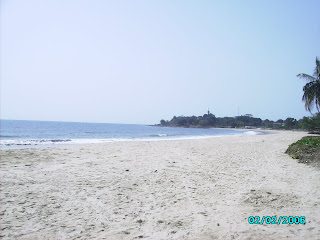The infra-structure still leaves a lot to be desired. The British Foreign and Commonwealth Office point out that there is no really risk-free way of going from the Airport to Freetown. What town planner came up with the idea of placing the International Airport, Lungi, at the other side of a wide estuary to the capital city? The link upon poor roads is 70 miles long. They advise against using water forms of transport at night. However I have done so on every trip I have made, apart from last year, when we stayed at a hotel before the ferry. This year the night ferry battled into a headwind, but it was fine and not so crowded as daytime.
Tourism is the fastest growing industry in the country and it is estimated to employ 8,000 people. Before the war (1991-2002), around 100,000 tourists came to Sierra Leone per annum. This fell to around the zero mark during the years of fighting. Recovery has been slow. There are guests at hotels, but few of them are tourists. They are either expats or business people.
My party has always been met at the airport and our friends have guided us through the throng of people wanting to help. A local hotelier has said, ‘I believe a sense of safety starts at the airport, its security and the handling process. If the airport is chaotic when you land, and people all over are coming up asking to help you when you don’t know who they are, people feel unsafe.’
The Winter months are the best time for tourists. The rainy season lasts from May to the end of October, with the heaviest rainfall being in July and August. This is the main time for holidays for those with children in school in the UK, but Easter or even Christmas would be much better.
A map of the Western Peninsula showing all the beaches mentioned below, although I note Bureh Town is called Bure Town! Note Kent and the Banana Islands at the bottom.
There are miles of lovely beaches, many in deserted areas, but this one, Lumley Beach is close to a number of hotels and beach bars. The Cape Sierra Hotel is on the headland.
This is Bureh Town Beach, where the local community engage in fishing from boats pulled up on the sand.
There is a local community association that provides basic accommodation and meals. We had a meal largely of lobster and it was delicious. In the background is some craftwork that we were invited to purchase.
The beach at Kent Village
At the village of Kent along from the beach is this headland. From it we are looking across to the Banana Islands. Our hosts in Freetown have suggested we make a visit to the islands on our next trip. The boats look a little primitive and I am glad that everyone appears to be wearing life jackets!
Kent has links with the slave trade, and the historical remains of this evil part of mankind's history have been developed in other African countries to attract tourists. In this slave house, the masters lived overhead while the slaves lived in the basement until they could be loaded onto ships to cross the Atlantic.
We were shown around by a local guide, but without many facts or stories of the days gone by. There are parts of the country where much work is being done to uncover the past and I am sure that the history will be better presented as it become more widely known.
I have always found the hotels adequate and we enjoy breakfast and an evening meal at the Hotel 5/10
Breakfast
Some hotels enjoy facilities such a swimming pools such as the one at the Airport Hotel.
We are considering staying here for our last night on the next trip (probably Easter 2012) so the Team can relax and have a debriefing session before heading home. This time we all visited the Crown Bakery in the heart of Freetown for coffee and cakes. This is a ex-pat home from home and very popular. Needless to say there are always a number of beggars outside.
Thinking of souvenirs to bring home? I would suggest wood carvings, some of which are excellent. They will be a wide variety of beads and clothing is very popular and colourful.
My children were delighted with these gifts - although the photo is some years old now!
A Freetown Hotel owner has said, ‘If I could give people one message it would be (that) Sierra Leone is open for business, we don’t need aid, we need investment, and with that investment things can be transformed here.’
Sierra Leone has just one national park at present, the Outamba-Kilimi National Park, though another five national parks have been proposed. The existing national park was established in 1986 and it’s located in the north west of Sierra Leone. There’s an assortment of wildlife such as elephants, chimpanzees, hippos and more and the landscape includes both savannah and jungle.
The potential is great and it is within reach!















No comments:
Post a Comment